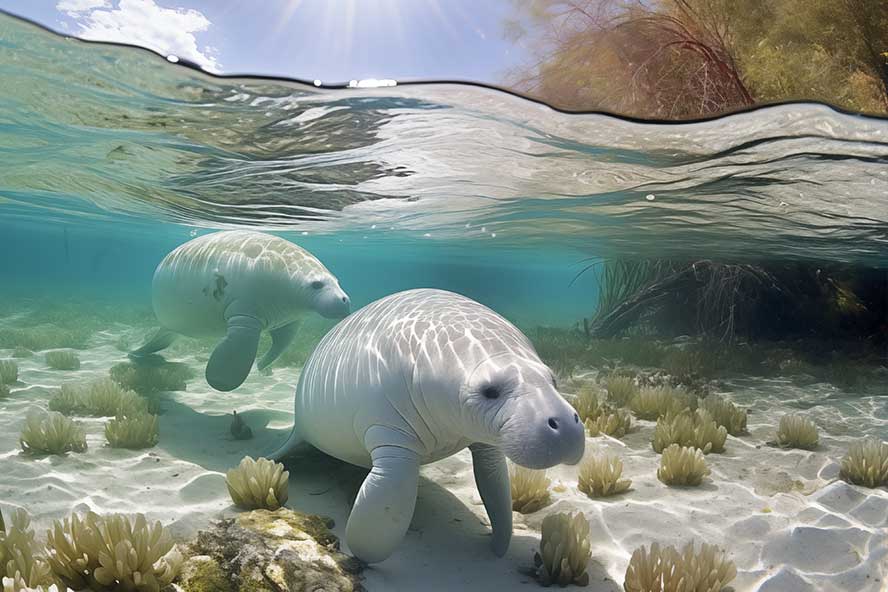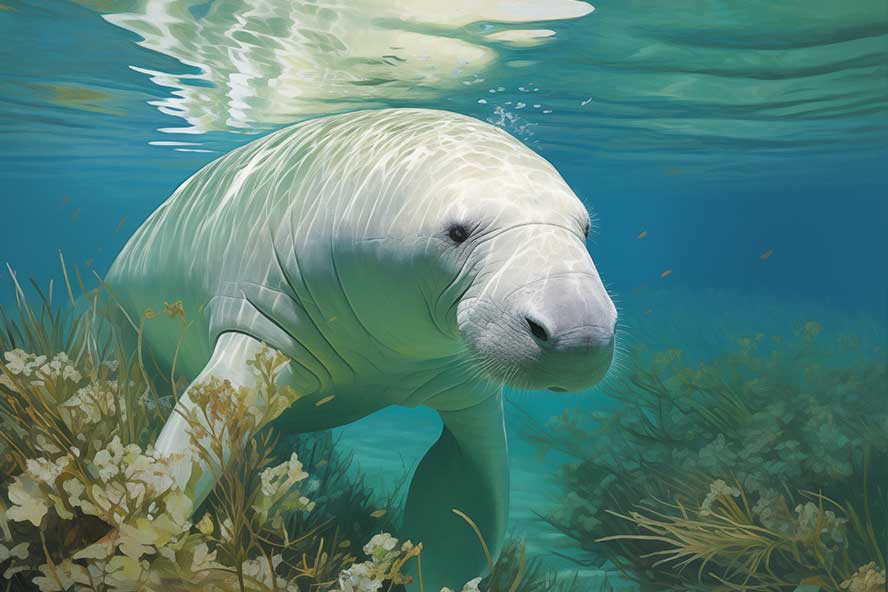Exploring the Mystical Dugongs of the Whitsundays and Their Coastal Habitats
Dugongs of the Whitsundays, often called sea cows, are fascinating marine mammals with a unique presence in the shallow coastal waters in Australia, including the pristine environments of the Whitsundays and the Great Barrier Reef. These gentle giants are not just a marvel to behold on a Whitsunday reef tour but are also pivotal in understanding the health and conservation of marine ecosystems.
Dugong Habitats and Lifestyle

The Whitsunday Islands: A Dugong Haven
The Whitsunday Islands provide a perfect backdrop for dugong sightings, thanks to their protected bays and abundant seagrass meadows. As highlighted by the Dugongs of the Whitsundays, these creatures prefer the tranquil waters around the islands, where they play a critical role in the ecological balance by grazing on seagrass.
Significance of Seagrass Meadows
Seagrass meadows are not just a food source for dugongs but are crucial for the marine environment’s overall health. They act as a nursery for various marine life and help stabilise the seabed. The importance of these meadows is well documented, with areas like Pigeon Island’s seagrass meadow being essential for both dugongs and turtles, as noted by the Whitsunday Conservation Council.
Conservation Efforts

Marine Mammals Conservation
Dugongs are protected under various conservation programs due to their status as vulnerable species. Efforts include habitat protection, research on dugong size and weight, lifespan studies, and implementing marine protected areas. The Great Barrier Reef’s comeback story for dugongs showcases the success of concerted conservation efforts.
Protected Species
The dugong, listed as vulnerable by the IUCN Red List, is protected under Australian law, including the Environment Protection and Biodiversity Conservation Act 1999 and the Great Barrier Reef Marine Park Act 1975. T
hese measures aim to conserve dugongs within critical habitats like the Great Barrier Reef Marine Park, acknowledging Australia’s role as a key global refuge for a significant portion of the world’s remaining dugong population. Despite these protections, dugong populations face threats from human activities, particularly along the urban Queensland coast where declines are noted due to boat strikes, fishing net entanglements, and habitat degradation. While some remote populations north of Cooktown in the Great Barrier Reef appear stable, overall mortality rates suggest current conservation efforts might not be sufficient to counteract the threats to this slow-breeding, long-lived species, underscoring the urgency for enhanced management and protection strategies.
Dugongs Of The Whitsundays FAQ
What makes dugongs different from manatees?
Dugongs and manatees are both part of the Sirenia order but differ in their tail shape and habitat preferences. Dugongs have a fluked tail, similar to a whale, and are found in coastal marine waters, while manatees have a paddle-shaped tail and inhabit freshwater environments.
How can tourists help in dugong conservation?
Tourists can contribute to dugong conservation by respecting wildlife guidelines during visits, supporting eco-friendly tours, and spreading awareness about the importance of marine conservation.
Why are seagrass meadows important for dugongs?
Seagrass meadows are the primary food source for dugongs. They play a crucial role in their diet and habitat, supporting their survival and the ecological balance of coastal marine ecosystems.
By understanding the unique lifestyle and conservation needs of dugongs in the Whitsundays, along with the significance of seagrass meadows as a marine life nursery, we can contribute to the preservation of these gentle giants for future generations.
What is being done to help sea grass in the Whitsundays?
Nicole Rosser, the owner of ZigZag Whitsundays Whitehaven Beach tour, is running a seagrass nursery, which entails removing epiphyte growth from the seagrass, keeping the pumps running, and dealing with any problems. She also has seagrass seed storage set up in the office, which is like having our little water feature. to find out more about what Nicole is up to around the Whitsundays and Great Barrier Reef see her story here
Check Out All The Tours
If you are looking to visit Whitehaven Beach or the Great Barrier Reef, see all the tours.
More Great Barrier Reef Information
Get in Touch
Have Questions?
Ask Nath J
74 Whitsunday Islands 1 Whitehaven Beach
Hi, I’m Nath J, a long-time local who’s been lucky enough to live and work tourism in the Whitsundays since 2001.
Over the past two decades, I’ve helped visitors discover the best of this incredible region, from Whitehaven Beach and Hill Inlet to the hidden spots only locals know about. I started out managing boats and tours, and these days I run Ripple Effect Online, a tourism-focused digital marketing business helping local operators grow and connect with travellers like you.
I’ve written an ebook called Whitsunday Islands: A Journey through Paradise, created countless local travel guides, and earned recognition as a “Whitsundays Tourism Hero” from QTIC for my contribution to the region and gained First Nations Cultural Protocol training through QTIC as well. But more importantly, I’ve spent years listening to travellers, understanding what makes a trip unforgettable, and helping people plan the kind of experience they’ll talk about for years.
If you’re planning a visit to Whitehaven Beach or anywhere in the Whitsundays, I’m here to help you make it amazing.
Find me on Facebook and LinkedIn or drop me an email at info@nath-j.au.
